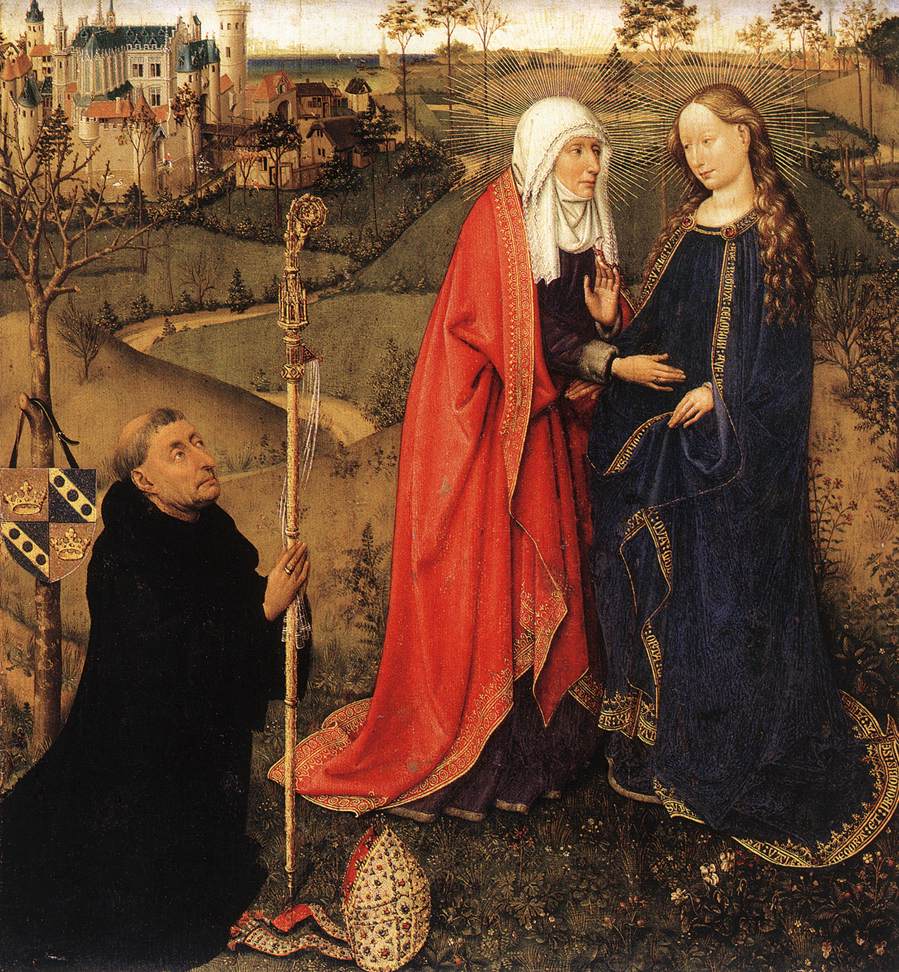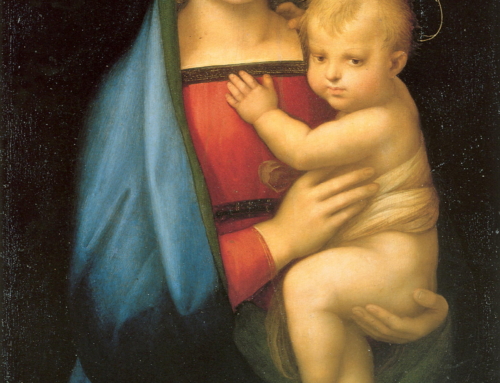The Visitation of the Blessed Virgin Mary to St Elizabeth is one of my favorite gospel stories about the Blessed Virgin because locked into this simple and beautiful account is so much genuine Catholic doctrine and devotion.
Here’s the gospel from today’s feast to refresh your memory:
Mary set out
and traveled to the hill country in haste
to a town of Judah,
where she entered the house of Zechariah
and greeted Elizabeth.
When Elizabeth heard Mary’s greeting,
the infant leaped in her womb,
and Elizabeth, filled with the Holy Spirit,
cried out in a loud voice and said,
“Most blessed are you among women,
and blessed is the fruit of your womb.
And how does this happen to me,
that the mother of my Lord should come to me?
For at the moment the sound of your greeting reached my ears,
the infant in my womb leaped for joy.
Blessed are you who believed
that what was spoken to you by the Lord
would be fulfilled.”
First of all, Luke uses the literary device of allusion to show that Mary is the Ark of the Covenant.
Scholars have commented on the parallels in this passage to David’s encounter with the Ark of the Covenant in I Samuel 5-6. Steve Ray’s article on it here at Catholic Answers is worth reading. Here is his summary:
- Mary arose and went to the hill country of Judea. I have been to both Ein Kerem (where Elizabeth lived) and Abu Ghosh (where the ark resided), and they are only a short walk apart. Mary and the ark were both on a journey to the same hill country of Judea.
- When David saw the ark he rejoiced and said, “How can the ark of the Lord come to me?” Elizabeth uses almost the same words: “Why is this granted me, that the mother of my Lord should come to me?” Luke is telling us something—drawing our minds back to the Old Testament, showing us a parallel.
- When David approached the ark he shouted out and danced and leapt in front of the ark. He was wearing an ephod, the clothing of a priest. When Mary, the Ark of the New Covenant, approached Elizabeth, John the Baptist leapt in his mother’s womb—and John was from the priestly line of Aaron. Both leapt and danced in the presence of the ark. The Ark of the Old Covenant remained in the house of Obed-edom for three months, and Mary remained in the house of Elizabeth for three months. The place that housed the ark for three months was blessed, and in the short paragraph in Luke, Elizabeth uses the word blessed three times. Her home was certainly blessed by the presence of the ark and the Lord within.
- When the Old Testament ark arrived—as when Mary arrived—they were both greeted with shouts of joy. The word for the cry of Elizabeth’s greeting is a rare Greek word used in connection with Old Testament liturgical ceremonies that were centered around the ark and worship (cf. Word Biblical Commentary, 67). This word would flip on the light switch for any knowledgeable Jew.
- The ark returns to its home and ends up in Jerusalem, where God’s presence and glory is revealed in the temple (2 Sm 6:12; 1 Kgs 8:9-11). Mary returns home and eventually ends up in Jerusalem, where she presents God incarnate in the temple (Lk 1:56; 2:21-22).
How does the Ark of the Covenant pre-figure the Blessed Virgin?
- It is covered in gold – the symbol of purity and royalty
- On the lid are two carved angels whose wings overshadow the ark. Mary is “overshadowed” by the Holy Spirit and Gabriel’s wings at the annunciation
- Inside the ark are the tablets of the law–the Word of God. Mary’s womb contains the Word made flesh.
- The ark also contains the rod of Aaron the shepherd-priest. Mary’s womb contains Christ the Good Shepherd and the great high priest of whom Aaron was a foreshadowing
- Inside the ark is the manna from the wilderness. Mary’s womb contains the true bread from heaven.
Second is the important detail that St Elizabeth is “filled with the Holy Spirit”. This is not just an indication that she was feeling happy and holy. It is an important sign that her words and actions are divinely inspired. She is being granted infallible revelation from God himself. This is similar to Jesus’ affirmation after Peter recognizes him as the Christ (Matthew 16:16-17) Jesus says, “Blessed are you, Simon son of Jonah, for this was not revealed to you by flesh and blood, but by my Father in heaven.”
So Elizabeth’s following words and actions are God-breathed.
Third is the use of the word “blessed”. This does not simply mean “lucky” or “fortunate.” It indicates, as in the passage from Matthew 16, a special grace from God. Saying that Peter was “blessed” is a recognition that what he witnessed and affirmed was not just a human insight. It was a divine revelation….a divine blessing.
Therefore Elizabeth’s words, “Most blessed are you among women” is not simply, “You’re a lucky gal.” It is another way of expressing the Angel Gabriels’s message, “Hail, Mary. Full of Grace.” Like Gabriel she is recognizing the fullness of God’s grace and blessing in Mary. In other words she is affirming Mary’s Immaculate Conception.
Fourth, Elizabeth, by divine revelation, recognizes Mary as “the Mother of my Lord.” Elizabeth is therefore acknowledging the fact of the incarnation. It has been revealed to her that Mary’s child is “her Lord.” There are various names for God in the Old Testament but “the Lord” is the name used for “Yahweh” (which was not to be spoken). Elizabeth later refers to God as “the Lord”. Therefore she not only recognizes and affirms the incarnation but connected with that…
…is the fifth point. If Mary is the Mother of her Lord, then Elizabeth is also recognizing Mary as theotokos – the God Bearer or as we say in the Latin church – the Mother of God.
Consequently, packed into this short passage we have Biblical support for the Immaculate Conception, the Incarnation and Mary Mother of God.
The beautiful thing for Catholics is that all of this is also caught up in the rosary. We don’t just see this as a point in apologetics, or a doctrinal statement to be affirmed. We pray it.
We enter into the two stories that affirm each other. We say with Gabriel, “Hail Mary, full of grace, the Lord is with you.” And we say with St Elizabeth, “Blessed are you among women and blessed is the fruit of your womb…Jesus.” Then we affirm the doctrine by saying, “Holy Mary, Mother of God…”
Pray for us sinners now and in the hour of our death.
This prayer takes us mystically into the heart of the mystery of the incarnation and does so with the same wonder, joy and gentleness expressed by Gabriel and Elizabeth.







Good summary. Another aspect of the overshadowing of Mary by the Holy Spirit is the prefiguring of this in the Old Testament when the cloud with the glory of the Lord overshadowed the Ark of the Covenant both in the meeting tent, so that even Moses could not enter (Exodus 40:34-35), and in Solomon’s temple, so that even the priests could not enter (I Kings 8:6-11). As regards the sanctity of the vessel of God’s holy presence among men, this indicates that the living “Ark of his Covenant” as realized in the Blessed Virgin Mary can rightly be elevated to special status in the heavenly temple (Rev. 11:19-12:1).